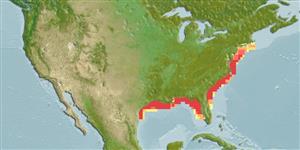Environment / Climate / Range
Ecology
Marine; brackish; demersal; depth range ? - 98 m (Ref. 89891). Subtropical, preferred ?; 43°N - 26°N, 98°W - 70°W
Western Atlantic: Massachusetts to Texas in the USA, except for southern Florida. Including Gulf of Mexico (Ref. 26938).
Size / Weight / Age
Maturity: Lm ? range ? - ? cm
Max length : 25.0 cm TL male/unsexed; (Ref. 7251); common length : 16.0 cm TL male/unsexed; (Ref. 3702)
Dorsal
spines
(total): 11;
Dorsal
soft rays
(total): 24-27;
Anal
spines: 2;
Anal
soft rays: 6 - 7. Colour greyish olive above, silvery white below. Back with 7 to 9 rather conspicuous dark vertical bars. Inside of opercle dark. Lower parts of pelvic fins, anal and caudal fins yellowish. A moderately small fish, body short and robust. Mouth large, strongly oblique, lower jaw projecting. Teeth very small and pointed, set in 1 or 2 rows along edges of jaws. Chin without barbels, but with 4 minute pores. Snout with 5 marginal pores and no rostral pores. Gas bladder simple, carrot-shaped, without anterior appendages. Sagitta (Large earstone) short but very thick (Ref 51721).
Occurs usually over mud and sandy mud bottoms in coastal waters to about 60 m depth, more rarely in estuaries. Feeds mainly on small shrimps.
Life cycle and mating behavior
Maturity | Reproduction | Spawning | Eggs | Fecundity | Larvae
Robins, C.R. and G.C. Ray, 1986. A field guide to Atlantic coast fishes of North America. Houghton Mifflin Company, Boston, U.S.A. 354 p. (Ref. 7251)
IUCN Red List Status (Ref. 115185)
CITES (Ref. 94142)
Not Evaluated
Threat to humans
Harmless
Human uses
Fisheries: of no interest; bait: usually
More information
ReferencesAquacultureAquaculture profileStrainsGeneticsAllele frequenciesHeritabilityDiseasesProcessingMass conversion
Tools
Special reports
Download XML
Internet sources
